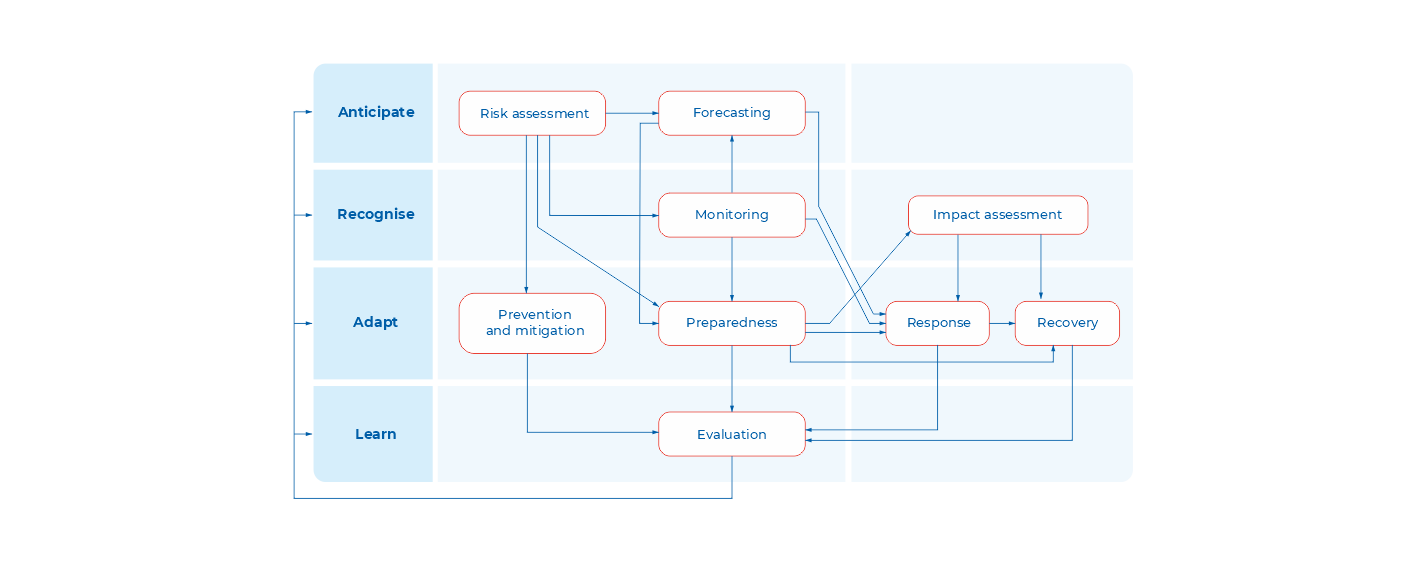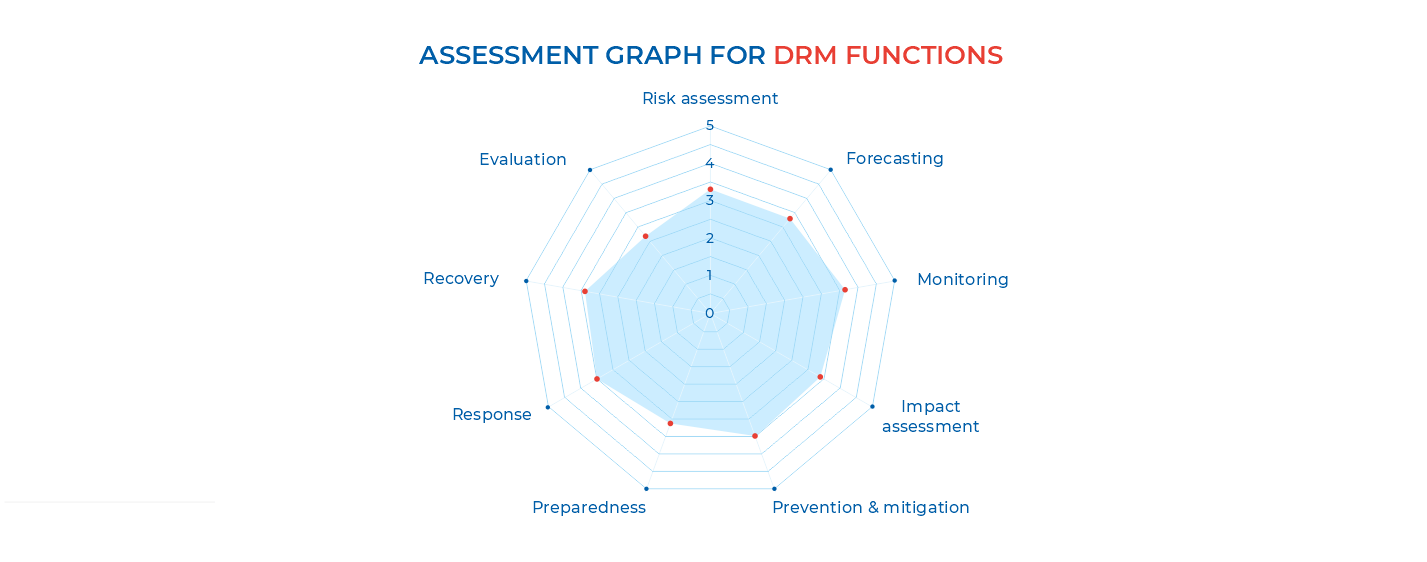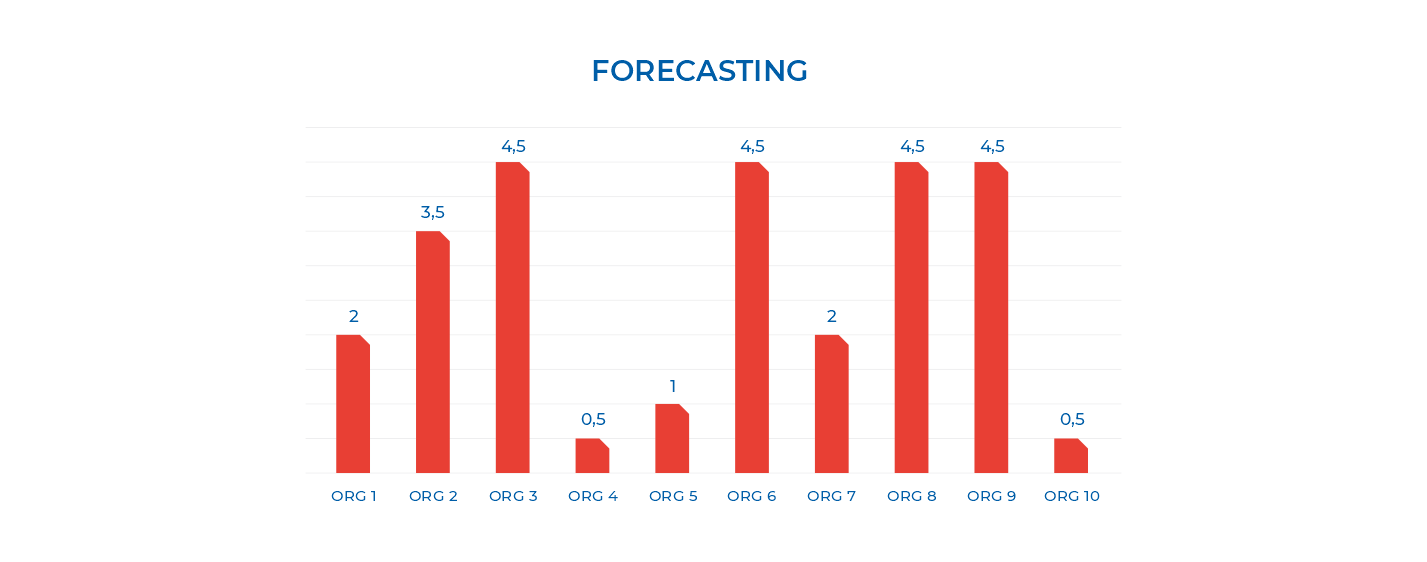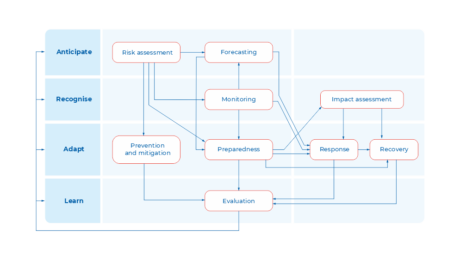Vol 82 – MONTHLY DISASTER REVIEW AND OUTLOOK

MONTHLY DISASTER REVIEW AND OUTLOOK
MAY 2023 | DISASTER MONITORING & ANALYSIS
(DMA) UNIT, AHA CENTRE
GENERAL REVIEW OF MAY 2023
For the month of May 2023, a total of 88 disasters were reported. The ASEAN Member States that were affected are Indonesia, Myanmar, the Philippines, Thailand, and Viet Nam. Most of the disasters (70%) occurred in Indonesia but only accounted for 8% of the affected persons (around 154,000). Notably, Myanmar accounted for most of the affected persons despite reporting only 1 disaster event—Tropical Cyclone MOCHA with 63% of the total reported affected persons for the month of May. The share of the disaster-affected people for the other ASEAN Member States are as follows: (1) Philippines-11%, (2) Thailand-18.12% and (3) Viet Nam-0.03%. May 2023 saw disasters affecting 284 per 100,000 people* and displacing 137 per 100,000 people* in the region, which were 3 times and 15 times higher respectively compared to the previous month.
Most of the disasters that have occurred in May 2023 are floods (51%) and is consistently the most recorded type of disaster for May of the previous year and May on a five-year average (2018-2022). The reported disasters in the region for May 2023 in comparison to the historical data (average for May 2018-2022) indicates that there were about 1.4x more reported disasters; 4.8x more people affected; 66x more people internally displaced; 7x more houses affected to some extent; 27x more lives lost; and 3.5x less people suffering injuries;.
Geophysically, 24 significant earthquakes (Magnitude ≥ 5.0) were reported by Indonesia’s Badan Meteorologi, Klimatologi dan Geofisika (BMKG), Thailand Meteorological Department (TMD), and the Philippine Institute for Volcanology and Seismology (PHIVOLCS).
Mount Semeru (Alert Level III), Anak Krakatau (Alert Level III), Ili Lewotolok (Alert Level II), Dukono (Alert Level II), and Ibu (Alert Level II) in Indonesia and Taal (Alert Level 2) and Kanlaon Volcanoes (Alert Level 1) were reportedly tectonically active (erupting lava or releasing gas or generating seismic activity) throughout the month of May 2023.
*computed based on 2023 population data from worldometers.com
ANALYSIS
According to the ASEAN Specialised Meteorological Centre (ASMC), compared to the average value from 2001-2022, during May 2023, less to near-average rainfall was experienced in Mainland Southeast Asia but more to near-average for the Maritime Continent. The largest difference (driest condition) from the average rainfall was observed over southern Myanmar and southern Thailand. Despite these dry conditions detected over Myanmar, a MAJOR disaster was caused by Tropical Cyclone MOCHA in its western and northwestern regions. As shown in Figure 1.a and 1.b, despite majorly exhibiting drier conditions, the areas within the track of cyclone MOCHA exhibited drier than normal conditions.
SEASONAL OUTLOOK
According to the ASEAN Specialised Meteorological Centre (ASMC), Southwest Monsoon conditions are expected to be established from June 2023 and persist until August 2023. These conditions traditionally bring rain often resulting in widespread and persistent shower activities in the northern ASEAN region. Over the southern ASEAN region, the Southwest Monsoon seasons is characterised by drier conditions compared to other times of the year, as the monsoon rain band typically lies further north from the Equator.
For the next 3 months, (June-July-August 2023), an increased chance of below-normal rainfall is predicted for much of the southern ASEAN region, with highest likelihood over the southern Maritime Continent. ENSO neutral conditions are present but will likely transition into El Nino in the next few months. Warmer-than-normal temperature is predicted for much of the ASEAN region.
Note: The qualitative outlook is assessed for the region in general and based on the latest runs from models provided by the SEA RCC-Network LRF node. For specific updates on the national scale, the relevant ASEAN National Meteorological and Hydrological Services should be consulted.
Sources: ASEAN Disaster Information Network (ADINet), ASEAN Disaster Monitoring and Response System (DMRS), ASEAN Specialised Meteorological Centre (ASMC), Badan Nasional Penanggulangan Bencana (BNPB) – Indonesia, Agensi Pengurusan Bencana Negara (NADMA) – Malaysia, Department of Disaster Management (DDM) – Myanmar, National Disaster Risk Reduction and Management Council (NDRRMC) – Philippines, Department of Disaster Prevention and Mitigation (DDPM) – Thailand, Thai Meteorological Department (TMD) – TMD, Badan Meteorologi, Klimatologi dan Geofisika (BMKG) – Indonesia, Pusat Vulkanologi dan Mitigasi Bencana Geologi (PVMBG) – Indonesia, Philippine Institute for Volcanology and Seismology (PHIVOLCS) – Philippines, Philippine Atmospheric Geophysical and Astronomical Services Administration (PAGASA) – Philippines
Written by : Keith Paolo Landicho, Sadhu Zukhruf Janottama, Lawrence Anthony Dimailig
DISCLAIMER
The AHA Centre’s estimation is based on data and information shared by National Disaster Management Organisations (NDMOs) and other relevant agencies from ASEAN Member States, international organisations, and news agencies. Further information on each recorded significant disaster, description, and detail of data and information are available at: https://adinet.ahacentre.org/report/
- Published in Monthly Disaster Outlook
Vol 82 – ROAD TO ARDEX-23

ROAD TO ARDEX-23:
FINAL EXERCISE PLANNING TEAM (EPT) MEETING AND REFEREE TRAINING FOR THE ASEAN REGIONAL DISASTER EMERGENCY RESPONSE SIMULATION EXERCISE 2023
The Final Exercise Planning Team (EPT) Meeting and Referee Training for the ASEAN Regional Disaster Emergency Response Simulation Exercise 2023 (ARDEX-23) recently took place from 8 to 11 May 2023 in Yogyakarta, Indonesia.
Hosted by the National Disaster Management Authority of Indonesia (BNPB) and the AHA Centre, as co-organisers, the Final EPT Meeting served as a continuation of the First EPT Meeting held in February 2023. During this gathering, the ASEAN Member States, BNPB Indonesia, AHA Centre, ASEAN Secretariat, and other stakeholders convened to solidify the Master Scenario Events List (MSEL), determine the level of participation from ASEAN Member States, establish the exercise control team structure, and make necessary logistics arrangements. These crucial elements are vital to ensuring the success of ARDEX-23, as they lay the foundation for effective coordination and response during the exercise. Held on 8-9 May 2023, the Meeting was officially opened by Deputy Minister of Logistics and Equipment of BNPB Indonesia Dr. Lilik Kurniawan, ST., M.Si.
Following the EPT Meeting, on 10-11 May a Referee Training session was conducted to define the roles and responsibilities of referees, and to standardise the evaluation process, and equip Referees with the necessary tools and provided with guidance to fulfil their tasks effectively, guaranteeing a seamless exercise. The Referees will play a crucial role during ARDEX-23, closely observing the exercise at both the Strategic and Operational Levels in order to gain insights that will serve as valuable references and planning parameters for future ARDEX exercises.
With the goal of testing and evaluating ASEAN’s emergency response and disaster management mechanisms, ARDEX is a full-scale simulation exercise that aims to enhance regional coordination and strengthen disaster resilience. The event, scheduled to be held from 31 July to 4 August 2023 at the Sultan Agung Stadium in Bantul, is expected to mark another significant milestone in the ASEAN calendar. Supported by the European Union through EU-SAHA, ARDEX-23 is poised to reinforce national and regional preparedness while facilitating a collaborative response to disaster emergencies.
ARDEX-23 holds significant importance in strengthening national, regional, and international coordination to achieve disaster resilience. Through the comprehensive testing, practising, reviewing, and evaluating of ASEAN’s emergency response and disaster management mechanisms, including the SOPs for the Coordination of EMTs, MNCC, and the ASEAN Militaries Ready Group on Humanitarian Assistance and Disaster Relief (AMRG on HADR), this regional exercise aims to enhance coordination capacity and preparedness. ARDEX exercises, which are conducted regularly every two years, have become key events in the ASEAN calendar and continue to contribute to the region’s disaster resilience efforts.
With ARDEX-23 on the horizon, the AHA Centre, BNPB Indonesia, ASEAN Member States, and stakeholders are gearing up to prepare for this vital regional exercise. As ARDEX continues to evolve, it reinforces the importance of preparedness and collaboration in effectively handling disaster emergencies in the ASEAN region and beyond.
Written by: Moch Syifa, Gladys Respati | Photo credits: AHA Centre
- Published in Highlight
Vol 81 – INTERVIEW WITH DIPO SUMMA RESOURCE MOBILISATION MANAGER AT THE AHA CENTRE

INTERVIEW WITH DIPO SUMMA,
RESOURCE MOBILISATION MANAGER AT THE AHA CENTRE
LACER’s Johanna Rixer sat down for a chat with Dipo Summa, Resource Mobilisation Manager at the AHA Centre and focal point for the LACER project, to discuss challenges, development and current priorities.
To what extent do differing capabilities among ASEAN Member States create challenges in effective regional response?
“The different capacities of the Member States is certainly a challenge in realising One ASEAN, One Response, Mr Summa says. The ambition to respond collectively as one is one of the biggest challenges, given that all Member States have different capacities. Even if the intention is shared by all. Having said that, there is a silver lining, a bright spot in the fact that the Member States already are capable to respond on an individual country level. It’s a matter of bringing the capacity under the regional umbrella. This is definitely a possibility for improvement within the next years of the AHA Centre’s development.”
What would you consider the best possible development of the AJDRP modules* in the future? In what ways could these be better aligned with current conditions and needs?
“The objective of the response plan is to be able to mobilise ASEAN resources, for immediate activation and deployment. If we can achieve that, we can find real satisfaction. We are truly working towards that goal and we need to have the resources and commitment of the Member States to achieve this. Right now we are in a quite good place with 5 Member States who have registered their assets, but it is not yet tested. This is our next step, to test and to see how it actually looks in practice.”
How can ASEAN deal with the growing differences in risk profiles among ASEAN Member States?
“Many of the aspects are beyond the control of the AHA Centre… what we can do is to focus on risk awareness, raising awareness and providing advice, rather than dealing with the issue of risk profiles as there are so many components that affect this. One mandate of the AHA Centre is to facilitate support when a disaster happens, and this can really help mitigate the disaster.”
How can AHA and ASEAN best assist Member States that face a recurring pattern of weather-related hazards including typhoons and flooding, along with associated displacement of populations? For instance, the Philippines during the period 2010−2021, reported more than 49 million people displaced, mostly triggered by storms. Is this a particular gap that ASEAN can help address?
“With regards to a recurring pattern of weather related hazards and climate change, here we are still focused on preparedness and response, capacity building programmes for member states and anticipatory actions. In this field there is room to do more… to develop a predictability system, supporting the Member States. This is also one of the priorities for the future.”
What do you see as other priorities for the AHA Centre in the coming 5 years?
“For me the AHA Centre will have several important priorities in the coming years. First, as outlined by the ASEAN Vision 2025, the AHA Centre should facilitate ASEAN responding collectively as one beyond the region. By 2024, the AHA Centre will conduct a feasibility study to create better understanding what this means. Secondly, the AHA Centre should continue to support innovation and implementation of new technologies in disaster management, in particular taking advantage of the continuous development in the field of big data analysis and artificial intelligence. Thirdly, the ASEAN Vision 2025 also mentioned the ambition to become a global leader in disaster management by leveraging through the long experience of the region in managing disasters in the region. To support this vision, the AHA Centre aims to become a regional knowledge hub on disaster management, where stakeholders can come to look for data, information and knowledge.”
* (deployable assets registered under the ASEAN Joint Disaster Response Plan)

Written by: Johanna Rixer | Photo Credit: AHA Centre
- Published in The Other Side
Vol 81 – INTERVIEW WITH LACER RISK ASSESSMENT EXPERT DR. EMMANUEL RAJU

INTERVIEW WITH LACER RISK ASSESSMENT EXPERT
DR. EMMANUEL RAJU
The AHA Centre held the Public Launch and Webinar of the 3rd edition of the ASEAN Risk Monitor and Disaster Management Review (ARMOR) on 11 October 2022, supported by the European Union (EU). The Levering ASEAN Capacities for Emergency Response (LACER) project contributed to the launch webinar.
The theme was the intersection of disasters and pandemic. Against the backdrop of the health crisis endured globally as a result of COVID-19, the articles highlight how the pandemic affected disaster management policymaking across the ASEAN region. Of particular interest is how ASEAN has adapted its disaster management tools in response to the pandemic, including innovative methods, information and communication technology that can be used to improve the analysis of real-time data and the cross-border provision of aid during disasters, in anticipation of future pandemics.
LACER risk expert, Dr. Emmanuel Raju, participated as a panellist commenting on the article “Disaster and Pandemic: The Exacerbating Effects of COVID-19 to ASEAN’s Disaster Riskscape” by the AHA Centre Disaster Monitoring and Analysis team and Pacific Disaster Center. Queried on how the pandemic had impacted disaster management in Europe, Dr. Raju noted a number of challenges and opportunities for learning which have emerged. A key learning in the context of natural hazards is the importance of talking about vulnerability as a central issue in disaster risk management because in many places, it is very often the same communities, the same geographic locations, where vulnerable populations are repeatedly impacted by disasters or have seen worsening effects over and over.
The pandemic has also forced us to revisit the link between Disaster Risk Reduction (DRR) and sustainable development.
“If we truly want to achieve disaster risk reduction, we also need to think about the sustainable development goals because at the end of the day disaster risk reduction is about making sure that we have risk-informed development processes.”
LACER Risk Assessment Expert, Dr. Emmanuel Raju
LACER’s Johanna Rixer caught up with Dr. Raju after the event and posed some further questions about learning.
How can academic learning best contribute to developing the capacity of an actor like the AHA Centre that is focused heavily on humanitarian response?
“This is an important question. Most professionals from academia would like to see impact, not only theoretically but to be able to go from theory to practice. We should use the experience of academia and put into practice what we learn. The discussions we had during the webinar are one example of such an opportunity. We also had a very interesting and fruitful workshop within the LACER project looking at risk from a scientific standpoint, where we had participants from the EU and the AHA Centre. The focus was to dig deeper on how we could use science to communicate risks in our day-to-day work. ”
How does the EU deal with differences in risk profiles among its members?
“It’s not easy. Different members have different interests. In this context it is important to continue to talk about impacts of climate change and extreme weather, as well as to nudge political actors to have these issues high up on the agenda. Disaster vulnerability is central to this discussion – both within the EU and the ASEAN. There are also lessons exchanged and learned between EU and ASEAN. Some factors continue to be central to the advancement of DRM in both Europe and ASEAN, such as applying lessons learned to leadership, keeping a focus on vulnerability, etc.”
What do you see as the priorities of ASEAN and the AHA Centre in the coming 5 years?
“Promoting localisation of efforts in disaster risk management, to allow a more robust and timely response and risk reduction efforts, will be of great significance to ASEAN over the next few years. And of course post-disaster, there is the issue of promoting recovery that is green and sustainable.”

Written by: Johanna Rixer | Photo Credit: AHA Centre, NORDRESS
- Published in The Other Side
Vol 81 – 17TH MEETING OF THE AHA CENTRE GOVERNING BOARD

17TH MEETING OF THE AHA CENTRE GOVERNING BOARD
After two years of meeting online, the 17th AHA Centre Governing Board (GB) meeting was held in hybrid format on 19 October 2022 as part of the 41st Meeting of the ASEAN Committee on Disaster Management (ACDM), 10th ASEAN Ministerial Meeting on Disaster Management (AMMDM), 11th Conference of the Parties to AADMER (COP to AADMER) and Related Meetings in Bangkok, Thailand. The meeting was chaired by the Department of Disaster Prevention and Management of Thailand.
During the meeting, the AHA Centre reported the activities conducted by the Centre from June to September 2022. It was a busy period as many activities that were previously held online were now being conducted face-to-face or in hybrid format. Within the reporting period, the AHA Centre was engaged in a total of 26 events and knowledge exchanges. Among these events, the AHA Centre was the organiser/co-organiser of 17 events, and participated in 12 events. The AHA Centre also organised or participated in 29 training activities and courses.
From June to September 2022, the AHA Centre’s Disaster Monitoring and Analysis Unit had recorded 418 disaster events in the ASEAN Disaster Information Network (ADINet) and disseminated 7 flash updates, 3 situation updates, 18 weekly disaster updates, and prepared 4 monthly disaster reviews and seasonal outlooks. The AHA Centre also conducted preparedness and response activities for the ASEAN Member States affected by Tropical Cyclone NORU, including the Philippines, Viet Nam, Lao PDR and Cambodia, and Thailand. Flash Update #1 and #2 were issued on 24 and 26 September 2022 respectively, followed by the issuance of Situation Update #1 on 27 September, Situation Update #2 on 28 September, and Situation Update #3 on 30 September 2022. Two Emergency Operations Centre (EOC) briefings were also held in response to Tropical Cyclone NORU, the first on 25 September 2022, and the second on 26 September 2022. The second EOC briefing was attended by all staff of the AHA Centre and the ASEAN Secretariat, to discuss the latest information on Tropical Cyclone NORU and the possibility of support that ASEAN and the AHA Centre can provide.
Following the meeting, the AHA Centre officially launched the second phase of the Project on Implementation of the Memorandum of Intent (MoI) of the AHA Centre and the Swiss Agency for Development and Cooperation (SDC), which will contribute to enhancing the capacity of the AHA Centre and ASEAN Member States in responding to disasters.
The Governing Board took note of the AHA Centre’s achievements within the reporting period, and commended the Centre for being on track to completing the majority of the activities planned for 2022. The AHA Centre is grateful for the continued guidance and support extended by the Governing Board, and hopes to carry forward the success of this year to 2023.
THE ACTIVITIES REPORTED WITHIN THIS PERIOD ALSO INCLUDED
The AHA Centre Executive (ACE) Programme on-site course
10 June – 10 August 2022, Thailand
The ASCEND Assessor Training
27 June-1 July 2022, in Ho Chi Minh, Viet Nam
The 13th ASEAN-Emergency Response and Assessment Team (ASEAN-ERAT) Induction Course
20-28 July 2022, in Hua Hin, Thailand
The 11th Meeting of the ASEAN-ERAT Advisory Group and 3rd Meeting of the Project Steering Committee for the ASEAN-ERAT Phase II Project
29 July 2022, in Bangkok, Thailand
The 2nd Emergency Operations Centre Exercise (EOCX)
3-4 August 2022, on-site at the AHA Centre and via video conference
The ACE Programme Graduation Ceremony and Evaluation Workshop
8 August 2022, Thailand
The 2nd Project Steering Committee (PSC) Meeting of the “Strengthening AHA Centre’s Capability to Respond Effectively to Human Induced Crises” (AHA-Australia)
29 August 2022, at the ASEAN Secretariat in Jakarta, Indonesia
The 2nd ASEAN Joint Disaster Response Plan (AJDRP) Workshop
31st August 2022, at the ASEAN Secretariat in Jakarta, Indonesia
Participation of ASEAN-ERAT members in the INSARAG Asia Pacific Regional Earthquake Response Exercise
5-8 September 2022, in Bali, Indonesia
The 5th ASCEND Project Steering Committee Meeting
6 September 2022, via video conference
The 7th Project Steering Committee Meeting of the ACE Programme
6 September 2022, via video conference
The 2nd AIM-Net Meeting & Workshop
12-14 September 2022, in Jakarta Indonesia and via video conference
The ASCEND Benchmarking Visit to South Korea,
26-30 September 2022, in South Korea
The ASEAN-ERAT Level 2 Course on Rapid Needs and Damage Assessment
26-30 September 2022, in Kuala Lumpur, Malaysia
The ASEAN-ERAT Level 2 Course on Information Management
3-7 October 2022, in Kuala Lumpur, Malaysia
The ARMOR 3rd Edition Public Launch and Webinar
11 October 2022, via video conference.
- Published in AHA Centre Diary 3
Vol 81 – THE 2ND ASEAN JOINT DISASTER RESPONSE PLAN WORKSHOP

THE 2ND ASEAN JOINT DISASTER RESPONSE PLAN WORKSHOP
The 2nd ASEAN Joint Disaster Response Plan (AJDRP) Workshop was organised on 31 August 2022 at the ASEAN Secretariat in Jakarta, Indonesia. Hosted by the AHA Centre and supported by the European Union, the workshop brought together representatives from the National Disaster Management Offices (NDMOs) of Brunei Darussalam, Indonesia, Lao PDR, Malaysia, Myanmar, the Philippines, Singapore, Thailand, and Viet Nam.
Also present at the event were representatives from the Mission of the European Union to ASEAN, the ASEAN Secretariat and the United Nations Office for the Coordination of Humanitarian Affairs (UNOCHA), as well as an observer from the United Nations Development Programme (UNDP). The event was opened by the H.E. Igor Driesmans, Ambassador of the European Union to ASEAN, who expressed his appreciation towards the commitment of the ASEAN Member States in developing the AJDRP.
Endorsed on 11 October 2016 at the 29th Meeting of the ASEAN Committee on Disaster Management (ACDM) in Manado, Indonesia, the AJDRP provides a common framework for operationalising the vision of One ASEAN One Response. It was developed to strengthen the implementation and interoperability of various ASEAN mechanisms, and enhance cooperation and coordination with established national and international mechanisms and the humanitarian community in the region.
Prior to the 2nd AJDRP Workshop, the ASEAN Member States had identified three possible large-scale emergencies with significant impact on the population in the ASEAN region during the inaugural Workshop held in 2016. These scenarios include a 7.2M earthquake in Metro Manila in the Philippines, a tsunami triggered by a megathrust earthquake in Indonesia, and a super cyclone in Myanmar’s Ayeyarwardy Delta. Subsequently, three country-level contingency planning workshops were held in Manila (Philippines) in October 2017; Nay Pyi Taw (Myanmar) in December 2017, and Jakarta (Indonesia) in March 2018.
Against this backdrop, the 2nd AJDRP Workshop was implemented with three main objectives in mind. First, to share the gaps and needs identified in the three country-level contingency planning workshops in Manila, Nay Pyi Taw, and Jakarta. Second, to develop a strategy for enhancing the coordination and potential mobilisation of resources with NDMOs and international organisations, in responding to the three aforementioned scenarios and other potential disasters, such as multi-hazard disasters. And third, to explore potential new scenarios for ASEAN’s joint collective response.
AC Abdul Razak Abdul Raheem, Director of the Planning and Organisation Department of the Singapore Civil Defence Force (SCDF) and Co-Chair of the ACDM Working Group on Preparedness, Response, and Recovery (PRR) said that the Workshop would continue ASEAN’s efforts to build on the AJDRP in the spirit of One ASEAN One Response. “On that note, let us look forward to an engaging and fruitful 2nd AJDRP Workshop,” he added.
The high level of enthusiasm and expertise brought by the workshop participants led to an intriguing and constructive exchange of ideas. A consensus was reached to move forward with an evaluation of the potential gaps or needs for the three AJDRP scenarios. To this end, the workshop participants came to the agreement that as the next step, the AHA Centre would need to work closely with the respective NDMOs of Indonesia, Myanmar and the Philippines to conduct the evaluation.
“This workshop will take us one step closer towards achieving the vision of One ASEAN One Response, which is the quick and well-coordinated deployment of the full range of capacities of ASEAN Member States, regional institutions, and humanitarian actors in the region, with potential support from the international communities if needed, to save more lives and prevent further losses from disasters.”
Mr. Lee Yam Ming, Executive Director of the AHA Centre

Written by: Gladys Respati | Photo credit: AHA Centre
- Published in AHA Centre Diary 2
Vol 81 – THE 2ND AHA CENTRE INFORMATION MANAGEMENT NETWORK (AIM-NET) MEETING AND WORKSHOP

THE 2ND AHA CENTRE INFORMATION MANAGEMENT NETWORK (AIM-NET) MEETING AND WORKSHOP
On 12-14 September 2022, the ASEAN Coordinating Centre for Humanitarian Assistance on disaster management (AHA Centre) organised the 2nd Meeting and Workshop of the AHA Centre Information Management Network (AIM-Net) in Jakarta, Indonesia. Twenty-three (23) representatives of the National Disaster Management Offices (NDMOs) of the ASEAN Member States (AMS) took part in the workshop, which was facilitated by the AHA Centre, Leveraging ASEAN Capacities for Emergency Response (LACER) Project, and Pacific Disaster Center (PDC).
Following up on the 1st AIM-Net Meeting held in February 2021, the 2nd AIM-Net Meeting and Workshop aimed to review the prioritised objectives of the AIM-Net Work Plan, familiarise participants with the AHA Centre Work Plan and the ICT Roadmap and their connection with the AIM-Net Work Plan, and finalise the AIM-Net Work Plan 2025 for Disaster Information Management (DIM) and Information Systems Interoperability (ISI).
AIM-Net is supported by the European Union through the EU-ASEAN Integrated Programme in Enhancing the Capacity of AHA Centre and ASEAN Emergency Response Mechanisms, known as EU-SAHA.
Representing the European Union Mission to ASEAN, Program Manager for Climate Change, Mr. Muammar Vebry, conveyed his optimism that the workshop could serve as a platform to coordinate and strengthen Disaster Information Management capabilities and Information Systems Interoperability between the ASEAN Member States, and strengthen the ties between the EU and ASEAN. “EU-SAHA, in a way, has managed to bring our two regions closer – conceptually, in terms of our approach, and in terms of our collaboration,“ he added.
At the meeting’s opening session, Executive Director of the AHA Centre Mr. Lee Yam Ming highlighted the importance of information management in disaster response. “Data and information are the bases of decisions that enable effective and efficient disaster management and facilitate appropriate and timely emergency response,” said Mr. Yam Ming. “In order to ensure well-informed and prompt decision-making, such data and information must be available, of quality, and accessible.”
However, among the ASEAN NDMOs there is a wide spectrum of technical capacities and capabilities on Disaster Information Management (DIM) and Information Systems Interoperability (ISI). Hence, ensuring the availability, quality, and accessibility of core datasets for disaster management and emergency response remains a challenge for ASEAN.
Against this backdrop, the AIM-Net was established to be a regional forum where the Emergency Operations Centres (EOCs) of NDMOs and the AHA Centre can coordinate and cooperate in strengthening capacities, capabilities, and practices on Disaster Information Management and Information Systems Interoperability.
“There is definitely homework to create and ensure the sustainability of disaster information management in our beloved ASEAN region,” said Dr. Raditya Jati, Deputy Minister of System and Strategy of the National Disaster Management Authority of Indonesia (Badan Nasional Penanggulangan Bencana – BNPB) and AIM-Net Co-Chair, “and that homework is to accomplish better together as One Community, One ASEAN, and One Response.”
During the workshop, AIM-Net Focal Points worked on refining the Network’s Work Plan, including its objectives, list of activities, timeline, and resources required, both in Disaster Information Management and Information Systems Interoperability. From this point, the AHA Centre will consolidate all inputs, refine the draft, and finally circulate the Work Plan to the ASEAN Committee for Disaster Management (ACDM) for finalisation and approval.
The workshop also marked the end of Indonesia and the Philippines’ Co-Chairmanship of AIM-Net, who had successfully led the Network through the 1st and 2nd AIM-Net Meetings and left the Network with the legacy of the AIM-Net Terms of Reference (ToR), ASEAN Disaster Information Management Strategic Framework, and the AIM-Net Work Plan. The Singapore Civil Defense Force (SCDF) and NDMO Lao PDR will now assume leadership of AIM-Net until 2023.
Mrs. Deniece Krizia Manding-Ballesteros, AIM-Net Co-Chair from the Philippines National Risk Reduction and Management Council – Office of Civil Defense (NDRRMC-OCD), commended the participants for the fruitful workshop and expressed her hopes for the future of AIM-Net. “With the success of this activity, I hope we will keep the same energy, commitment, enthusiasm, and level of participation for the next activities of AIM-Net until 2025 or further. I have confidence that the next AIM-Net co-chairs, NDMO Lao PDR and SCDF Singapore will guide the network for the realisation of these goals and activities,” she said.
The three-day event concluded with a visit to the Emergency Operations Centres (EOCs) of BNPB and the AHA Centre, which facilitated the sharing of knowledge and experience in disaster information management. The 3rd AIM-Net Meeting is targeted to be held in 2023, and will include a workshop on DIM and ISI, training needs assessment, and study visit of the host country’s EOC.

Written by: Gladys Respati | Photo credit: AHA Centre
- Published in AHA Centre Diary 1
Vol 81 – LACER INTRODUCES A STRATEGIC TOOL FOR ENHANCING DISASTER MANAGEMENT IN THE AHA CENTRE AND BEYOND

LACER INTRODUCES A STRATEGIC TOOL FOR ENHANCING DISASTER MANAGEMENT IN THE AHA CENTRE AND BEYOND
The EU-funded LACER project aims to sharpen procedures for strategic planning and programming in ASEAN´s disaster management capacities. The disaster risk management (DRM) tool used by LACER is intended to support the elaboration of plans for capacity development projects and to assess the strengths and weaknesses of DRM systems in any part of the world. Peter Månsson, after obtaining a PhD in disaster risk management, was recruited to the project in 2021, bringing with him the methodology originally developed at Lund University and subsequently adopted by the Swedish Civil Contingencies Agency (MSB).
Aside from assessing the disaster management capacities of the AHA Centre, the tool can support the mapping of external support and the existing institutional framework. Moreover, it may be used for assessing and comparing disaster management capabilities of ASEAN Member States. Such an overview would enable the AHA Centre to guide the Member States toward developing specific disaster management abilities. This would not only benefit members but allow the AHA Centre to play a pivotal role as a mediator of cross-border collaboration and peer-to-peer learning, while strengthening disaster management capabilities across the region.
Figure 1. Key functions of DRM-systems and some of their interdependencies

Protecting human values and learning from disasters
The DRM tool is a refinement of a method for assessing community resilience, which further builds on an established theory of resilience engineering and the four cornerstones of resilience.1
The purpose of DRM systems is to protect what human beings value and, to achieve that, the systems need to anticipate, recognize, adapt to and learn from disasters and other types of disturbances to societal safety. DRM systems need to be able to perform a set of functions where anticipation is ensured through the functions of risk assessment and forecasting. To recognize when disasters are about to occur, or have happened, we need the functions of monitoring and impact assessments. To adapt societies to safeguard what humans value, we utilize the proactive functions of prevention/mitigation and preparedness as well as the reactive functions of response and recovery. Finally, to continuously learn and develop safer societies, we need the function of evaluation to enhance the impact of DRM systems.
These functions are not only vital in themselves, but also dependent on each other in such a way that the performance of one function requires the output from another function, e.g. to warn the public to take shelter against a coming cyclone necessitates information from forecasting or weather monitoring.
Figure 3. Column type graphs are useful for comparing various organizations and realize who may learn from whom relative to these functions.

Using the tool for capacity assessments
While these functions are general for all DRM systems in the world, the specifics of how they are implemented, by who and with what resources vary greatly from country to country. Assessing the capacity to perform each function in a specific country entails analyzing what actually exists in that context in order for each function to work. To do this in the ASEAN context, the LACER project developed a survey that contains a number of statements related to these factors, which need to be assessed for each function for a comprehensive analysis of capacities of the DRM system. The results of the survey may be visualized with the help of a “spider graph”, which shows where the prerequisites for performing the functions are adequate or may be improved (Fig. 2). The traceability of the tool enables the user to identify which aspects are judged to be substandard and need to be developed in order to enhance the performance of a specific function.
In addition, the tool may be used to compare assessments of different organizations with each other. For example, assessments of various national disaster management organizations (NDMOs) may reveal who can learn from others regarding a specific DRM function. Such an overview could provide the AHA Centre a means for instigating and facilitating cross-border collaboration in support of proactive disaster management to the benefit of the region at large.
Yet, graphs of ten different NDMOs would make a spider chart cluttered and the information hard to distinguish. Hence, for comparisons across organizations it is better to use one chart per function and bar graphs, where the NDMOs are shown as different columns on the x-axis and their capabilities on the y-axis (see Fig. 3).
Figure 3. Column type graphs are useful for comparing various organizations and realize who may learn from whom relative to these functions.

Using the tool for mapping institutional frameworks and donor support
During the fall of 2021, the tool was used by the LACER project for two additional purposes: to attain overviews of 1) the institutional framework of the AHA Centre and 2) the support it receives from external partners.
In the first case, legislative requirements, guidelines and standard operating procedures of the AHA Centre and the EU Civil Protection Mechanism were compared. In the latter case, the tool was used to analyze all support received by the AHA Centre from external agencies and donors, by looking through the lens of capability for each function.
Importantly, the AHA Centre receives support from 31 external agencies. The results, however, suggest that external support is unevenly distributed over the functions, with certain functions such as Preparedness, Response and Recovery receiving the lion´s share of support and interest from external funders whilst other functions such as forecasting and impact assessment receive little attention. Since the nine general functions are mutually dependent, it makes sense for a DRM organization pursuing a balanced approach in terms of institutional frameworks and support from external partners. Depending on the outputs of capacity assessments, an organization may opt to seek greater external support for some particular functions. Such imbalances, however, should be based on thorough assessments and conscious strategic decisions rather than ad hoc opportunities for funding.
Having a sound understanding of one’s own deficiencies and development needs shows strategic depth and indicates the presence of a serious partner that has a clear idea about which capabilities need to be addressed to become an even stronger player in the field of disaster management. The tool described here is a means to this end.

1 The theoretical basis of the tool is described in Becker, P., Abrahamsson, M., & Tehler, H. (2014). An emergent means to assurgent ends: Societal resilience for safety and sustainability. In C. P. Nemeth, & E. Hollnagel (Eds.), Resilience Engineering in Practice, Volume 2: Becoming Resilient (pp. 1-12). Boca Raton: CRC Press.
Written by: Dr. Peter Månsson, LACER Organisational Development Expert.
- Published in Partnership
Vol 81 – MONTHLY DISASTER REVIEW AND OUTLOOK

MONTHLY DISASTER REVIEW AND OUTLOOK
SEPTEMBER 2022 | DISASTER MONITORING & ANALYSIS
(DMA) UNIT, AHA CENTRE
GENERAL REVIEW OF SEPTEMBER 2022
For the month of September 2022, a total of 193 disasters or a daily average of 6 disasters were reported. Compared to the previous month (August), this is more than twice as many and 1.5x higher compared to September of the previous year. This is also 3.4x higher than the five-year average (2017-2021) of disaster occurrences for the month of September. September 2022 saw disasters affecting 596 per 100,000 people* and internally displacing 10 per 100,000 people*. From the start of the year 2022, a total of 11.6M persons have been affected by disasters or an average of 42,591 persons in a day. This total is already 1.2M or 11% higher than the same period of the previous year.
The ASEAN Member States that were affected are Cambodia, Indonesia, Malaysia, the Philippines, Thailand, and Viet Nam. Most of the disasters (68%) occurred in Indonesia but only accounted for 8% of the total reported affected persons for September 2022. Thailand, despite accounting for only 6% of the disaster occurrences for the month, accounted for 73% (2,916,745) of the total reported affected persons for the month. On one hand, the share of disaster occurrences for the other member states are as follows: Cambodia – 3%, Malaysia – 3%, The Philippines 8%, and Viet Nam – 10%. On the other hand, the share of affected persons for the other member states are as follows: Cambodia – 0.001%, Malaysia – 0.0004%, the Philippines – 37%, and Viet Nam – 1.6%.
Most of the disasters that have occurred in September 2022 are floods (63%) and is consistently the most recorded disaster-causing natural hazard for September of the previous year and September on a five-year average (2017-2021). The reported disasters in the region for September 2022 in comparison to the historical data (average for September 2017-2021) indicates that there were about 3.4x more reported disasters; 1.08x less people affected; 2.4x less people internally displaced; 9.8x more houses affected to some extent; 8.5x less lives lost; 12x less people suffering injuries; and lastly, 28x less people that have gone missing. The main drivers of the impacts in the ASEAN region were the monsoon situation in Thailand that have caused widespread flooding as reported by the Department of Disaster Prevention and Mitigation (DDPM) and the impacts of Tropical Cyclone (TC) NORU in the Philippines, Viet Nam, Lao PDR, Cambodia, and Thailand. The tropical cyclone affected multiple member states, but the Philippines’ resources were sufficient, and Viet Nam was able to prepare well. Thailand had requested for relief items in response to TC NORU-associated flooding which has worsened the situation in areas that have long been impacted by the monsoon situation.
Geophysically, 43 significant earthquakes (Magnitude ≥ 5.0) were reported by Indonesia’s Badan Meteorologi, Klimatologi dan Geofisika (BMKG), the Philippine Institute for Volcanology and Seismology (PHIVOLCS), the Thai Meteorological Department (TMD), and the Department of Meteorology and Hydrology (DMH) of Myanmar. This emphasizes the importance of disaster preparedness as three ASEAN Member States lie on the “Pacific Ring of Fire,” a zone of active volcanoes and frequent earthquakes.
Mount Semeru, Ili Lewotolok (Alert Level III), and Ibu, Dukono (Alert Level II) in Indonesia and Taal Volcano (lowered to Alert Level 1), Mayon, Mount Kanlaon (Alert Level 1) were reportedly tectonically active (erupting lava or releasing gas or generating seismic activity) throughout the whole of September 2022.
*Computed based on 2020 population data from worldometers.com
SEASONAL OUTLOOK
For the month of September 2022, much of the ASEAN region experienced rainfall more than what is traditionally experienced for the month. Wetter conditions (compared to the average for September 2022) were recorded over Viet Nam and Southern Borneo hence the hydrometeorological-induced disasters in Viet Nam and Indonesia. In contrast, below-average to average rainfall were recorded in Peninsular Malaysia, the Philippines, and Northern Myanmar, northern Lao PDR, northern Sumatra and northern Papua of Indonesia. Despite this, hdyrometeorological hazard-induced disasters still occurred in most of these areas (except northern Myanmar, northern Lao PDR, and northern Papua).
According to the ASEAN Specialised Meteorological Centre (ASMC), for the October-November-December period much of the ASEAN region will be experiencing above-normal rainfall. Normally, this period is regarded as the disaster season for the region. This is on top of the traditionally wet monsoon seasons in Thailand (May-October), Cambodia (May-October), Lao PDR (May-October), Viet Nam (May-November), the typhoon season in the Philippines (July-October) and the start of the rainy season in Indonesia (November-March). Therefore, the threat of hdyrometeorological hazard-induced disasters is even more likely.
In terms of temperature, below- to near-normal temperatures are favoured for parts of the equatorial region and much of the Mainland Southeast Asia, with above-normal temperature favoured elsewhere which likely means for hotspot activities to generally be subdued for the period.
The qualitative outlook is assessed for the region in general. For specific updates on the national scale, the relevant ASEAN National Meteorological and Hydrological Services should be consulted. More outlook and verification plots, including for tercile and quintile probabilistic forecasts for temperature, are in the “Model products and verification: NCEP, ECMWF, UK Met Office” on the SEA-RCC Network LRF Node webpages.
Sources: ASEAN Disaster Information Network (ADINet), ASEAN Disaster Monitoring and Response System (DMRS), ASEAN Specialised Meteorological Centre (ASMC), Badan Nasional Penanggulangan Bencana (BNPB) – Indonesia, Agensi Pengurusan Bencana Negara (NADMA) – Malaysia, National Disaster Risk Reduction and Management Council (NDRRMC) – Philippines, Department of Disaster Prevention and Mitigation (DDPM) – Thailand, Thai Meteorological Department (TMD) – TMD, Viet Nam Disaster Management Authority (VNDMA) – Viet Nam, Badan Meteorologi, Klimatologi dan Geofisika (BMKG) – Indonesia, Pusat Vulkanologi dan Mitigasi Bencana Geologi (PVMBG) – Indonesia, Department of Meteorology and Hydrology (DMH) – Myanmar, Philippine Institute for Volcanology and Seismology (PHIVOLCS) – Philippines, Philippine Atmospheric Geophysical and Astronomical Services Administration (PAGASA) – Philippines
Written by : Keith Paolo Landicho, Sadhu Zukhruf Janottama, Lawrence Anthony Dimailig
DISCLAIMER
The AHA Centre’s estimation is based on data and information shared by National Disaster Management Organisations (NDMOs) and other relevant agencies from ASEAN Member States, international organisations, and news agencies. Further information on each recorded significant disaster, description, and detail of data and information are available at: http://adinet.ahacentre.org/reports.
- Published in Monthly Disaster Outlook
Vol 81 – ADDM & IDDRR 2022: SYNERGISING REGIONAL AND GLOBAL ACTION FOR DISASTER RESILIENCE

ADDM & IDDRR 2022:
SYNERGISING REGIONAL AND GLOBAL ACTION FOR DISASTER RESILIENCES
Every year, disasters triggered by natural and non-natural hazards affect millions of people globally. As one of the most disaster-prone regions in the world, ASEAN is particularly vulnerable. From 2015 to 2021, 104.2 million people1, or about one in four people in the region, were affected by disasters. Meanwhile, the total economic loss suffered by ASEAN Member States during this period reached a staggering US$11.1 billion.
However, the impact of these disasters can be lessened through systematic efforts to identify, assess, and reduce the causal factors of disasters. This is known as Disaster Risk Reduction or DRR in short. Disaster Risk Reduction itself is part of Disaster Management, which the United Nations Office for Disaster Risk Reduction (UNDRR) defines as “the organisation, planning and application of measures preparing for, responding to and recovering from disasters2.”
The complexity of disasters and their wide-ranging effects mean that the cooperation of multiple stakeholders is vital to disaster management. Over the years, ASEAN and the AHA Centre have had the privilege of partnering with a wide range of governments, institutions, and organisations. These partnerships have played valuable roles, ranging from direct financial support, bringing in skilled professionals to provide key technical inputs, to partnerships based on knowledge sharing and capacity building.
To sustain these partnerships and enhance awareness of national and regional activities related to disaster management and risk reduction, the ASEAN Ministers responsible for disaster management designated 13 October as the ASEAN Day for Disaster Management (ADDM), which is observed jointly with the UN’s International Day for Disaster Risk Reduction (IDDRR).
This year’s ADDM celebration took place on 20 October in Bangkok at the margins of the 11th ASEAN Ministerial Meeting on Disaster Management (AMMDM) and 10th COP to AADMER. The theme of ADDM 2022, “Stronger Together in Balancing Action to Enhance Localisation for Disaster Resilience,” dovetails with target G of the Sendai Framework that aims to increase access to multi-hazard early warning systems and disaster risk information and assessments to people.
In his remarks, AMMDM Chair General Anupong Paochinda emphasised that “the themes of ADDM and IDDRR this year call for collaboration and support from all sectors in making our local communities resilient by equipping them with disaster risk information, early warning system, and means of disaster preparedness.’’
The AHA Centre supports ASEAN Member States in this endeavour through one of its core functions, namely disaster information management. Utilising the ASEAN Disaster Monitoring and Response System (DMRS), the Centre works with Member States to monitor hazards, collect, analyse, and disseminate key relevant information to support disaster management.
The AHA Centre also disseminates information on a regular basis to the public, through Flash Updates and Situation Updates during emergency times, as well as Weekly Disaster Updates and the Monthly Disaster Outlook and Review in non-emergency times. Additionally, in May 2022, ASEAN launched the Framework on Anticipatory Action in disaster management, that will guides the ASEAN Member States in implementing anticipatory action in disaster risk management (DRM) at the regional, national, and local scale through joint regional efforts.
To become a truly disaster-resilient region, going forward, it will become increasingly important for ASEAN and its partners to synergise regional and global efforts in disaster management that not only target institutions, but also communities and individuals at the local level.
1 Based on ADINet records from reports from NDMOs and official information sources.
2 https://www.undrr.org/terminology/disaster-management
Written by: Gladys Respati | Photo credits: DDPM Thailand, AHA Centre
- Published in Highlight






































